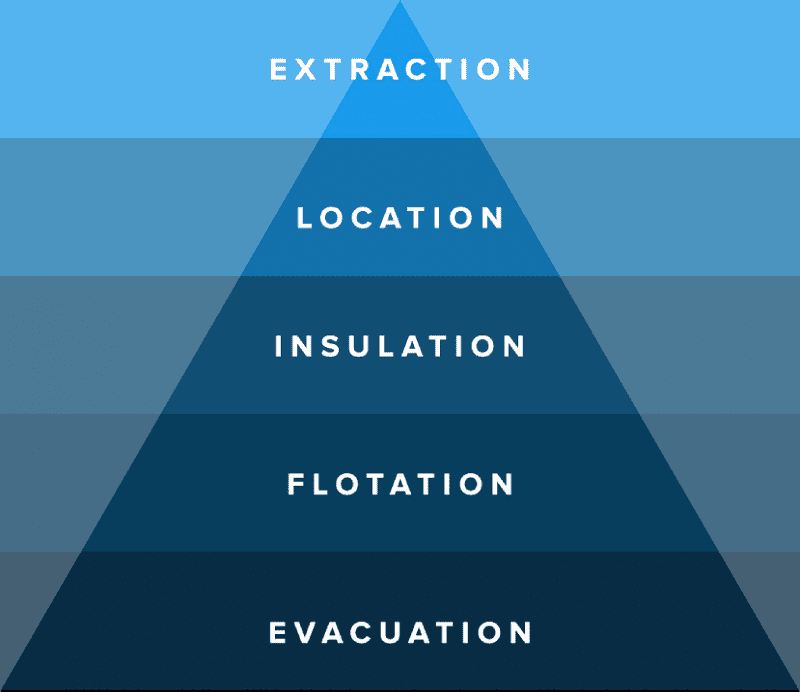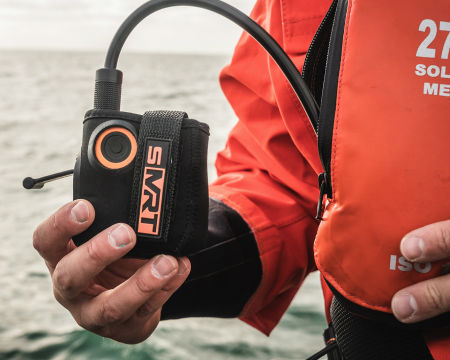What is ELIFE?.
ELIFE – The MASLOW of MOB Survival
When it comes to surviving going overboard, 5 key aspects are each in turn pivotal to ensure a safe rescue. If you remove one of the 5 aspects, you significantly reduce your chances of survival. Based on the principle of Maslow's hierarchy of needs, the model is called ELIFE.

Let's look at the 5 aspects in more detail.
Evacuation
If you have ended up in the water as a result of falling over the side, this aspect is irrelevant as you weren’t supposed to evacuate. However, should you be on a ship that is sinking a clear evacuation plan is imperative to getting away from danger safely?
Flotation
Ok, so you're in the water, the first thing you need to do to stay alive is keep your head above the water. You could be conscious and in a clear state of mind, however, you could have had a fall from height, be unconscious or just suffered from cold water shock. In any scenario a SOLAS 275N or 150N PFD will automatically activate once you hit the water, it will automatically put you on your back if you are face down and will ensure your airways are kept clear and above the water at all times.
Insulation
You're in the water and floating with your airways clear so the next question is, how long is help going to take to get to you? The answer is you don't know. In waters under 39°F, the estimated survival time is 30-90 minutes depending on fitness and body type, you can expect to be unconscious or experience exhaustion within just 15-30 minutes. This time can be significantly increased by wearing an immersion suit, known as a gumby suit, by some, it will keep you insulated and dry whilst in the water.
Location
You're keeping afloat, your airways are clear and you're wearing an immersion suit that will give you valuable extra time, however, the next question is, does anybody know you are there and if so, how can they locate you? Wearing a Personal Locator Beacon (PLB) such as the sMRT AU10 or V100 which will automatically activate when you hit the water whether your life jacket activates or not, or even if you are unconscious, injured or incapacitated in any other way. A distress alert is sent which ensures that everybody in the transmission range (up to 75NM surface to air) knows you are thereby sounding a 121.5MHz / VHF DSC alarm. More importantly, it will also allow you to be tracked and located accurately, via AIS to within +/-10 metres.
Extraction
You have given yourself the best possible chance of survival by wearing a lifejacket and are equipped with a PLB, which will pinpoint your location. Now it is down to your crew or Search and Rescue teams to ensure they locate you and remove you from the water as quickly and as safely as possible.
The most important rule of going to work or is returning home to your family and loved ones at the end of the day. Working on, besides and around the ocean is dangerous, ensuring you and your colleagues follow the ELIFE Hierarchy of needs could be the difference between saving and losing a life.
Want to find out more?
If you would like to find out more about our ELIFE model, then don’t hesitate to get in touch with us today via info@mrtsos.com.
Article First Written:
11/03/2018
- What is a Personal Locator Beacon (PLB)?
- How Does a Personal Locator Beacon Work?
- What are the different types of PLBs?
- What are Local Area Systems?
- What is ELIFE?
- What is a True Water Activating PLB?
- What is the difference between a PLB and an EPIRB?
- What Is AIS, VHF and DSC?
- What is a 406 MHz PLB?
Contact Us
Find Us
Marine Rescue Technologies Limited
Wescom Group,
Unit J1, Springfield Way,
Anlaby, HU10 6RJ


